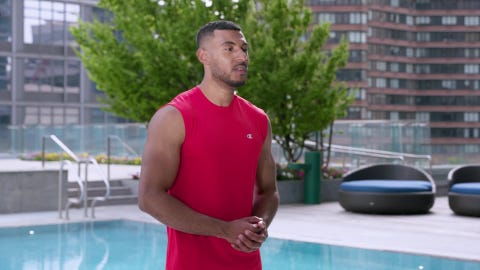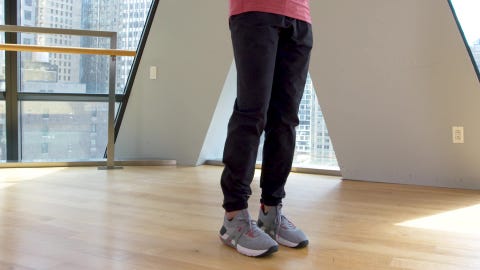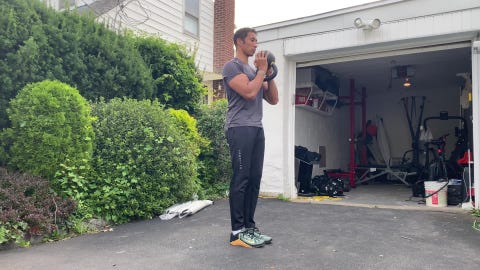LEG DAY WORKOUTS can be overwhelming when you want to do more than the bare minimum to challenge your lower body. Do you go with the squat, leg press, or deadlift? Those can all be great choices to target your quads, hamstrings, and glutes—but all of those exercises keep your feet planted firmly on the floor. When your goal is to develop leg strength, balance, and athleticism along with building muscle, you need to get moving. That’s when you should add lunges to your routine.
Standard lunges require you to step forward, and you can even string reps together to move from one end of the gym to the other. This can be a major benefit for your training goals—but for some people, knee problems can make lunges a major pain. Solution: shift your lunges into reverse. When you step back into the exercise, rather than forwards, you’ll avoid the likelihood that you’ll translate the front knee too far forward and into painful positions. Even better, you’ll be able to replicate the forward drive you get during explosive movements like sprinting. “It’s a nice, athletic way to come out of a lunge,” says Men’s Health fitness director Ebenezer Samuel, C.S.C.S.
There’s more to the reverse lunge than just dropping a leg behind yourself and sinking down. Make sure to keep note of the subtleties of the movement before putting it into practice yourself, for safer, smarter leg day workouts.
Benefits of Reverse Lunges
Unlike squats and deadlifts, which are bilateral exercises (engaging both sides of your body working together), reverse lunges allow you to train unilaterally, working one side of your body at a time. Unilateral exercises can be valuable tools in your training kit to address muscle imbalances, helping to make your body more symmetrical (and thus, less prone to injuries). Since you’re working with one side at a time, you’ll also hone your balance and coordination, which is a boon to your athletic endeavors. You’ll target your quads, hamstrings, and glutes, hitting most of the major muscles in your lower body.
Again, the advantage of the reverse lunge over the standard forward lunge variation is that you’ll be able to prevent your front knee from translating too far forward and causing pain, which is a fairly common issue. The reverse lunge variation allows you to drive forward as you stand up, mimicking the explosive movement of sprinting.
Since reverse lunges leave your arms free, you can use just about any loading implement to add resistance, too. Work with just your bodyweight to start, but you can supplement your training with dumbbells, kettlebells, barbells, sandbags, and more, held in multiple positions. The world is your oyster—once you have the basic form down, of course.
How to Do the Reverse Lunge
●Stand with your feet shoulder-width apart. Squeeze your glutes and shoulder blades, keeping your gaze neutral at a point straight ahead of you.
●You can perform lunges with only your bodyweight, or use a wide range of implements like dumbbells, kettlebells, or barbells held in a number of positions. For simplicity’s sake, start by holding a pair of dumbbells, one in each hand at hip-level.
● Step one leg back and slightly out, landing with your toe first. Work to avoid slamming your knee into the ground. Keep your chest in an upright position, bending your knees to form right angles with both of your legs.
●Drive off the ground with your front foot and step your rear leg forward into the starting position. Keep your torso in a solid upright position by squeezing your core to stay balanced.
●Perform 3 sets of 8 to 10 reps per leg, or work for time with 45 seconds on, 15 seconds off for 5 minutes.
3 Reverse Lunge Variations
Once you’re used to the standard version of the reverse lunge, you can give these variations a try to level up your training.
Reverse Lunge Level-Up
Add another athletic element to your lunge with this summer-friendly variation.
●Stand with your feet together, squeezing your core, with your gaze straight ahead. Step back into a reverse lunge, bending your knees at around 90 degree angles. Cycle your arms like a sprinter (i.e. if you step back with your right leg, swing your left arm up). For this particular variation, it’s okay to allow your torso a bit of a forward lean—that will help with what comes next.
●Drive your rear knee up to stand, holding it in an elevated position for a quick beat. Again, cycle your arms in sync with your legs.
●Step back again into a lunge with that same leg. As soon as your rear foot plants, press off the ground to quickly switch your feet. Cycle your arms as if you were running. Use Khan’s cue to help nail the rhythm: Drive, Switch.
●Move directly into the next rep with the opposite leg.
●Perform 2 to 3 rounds of 10 reps per side.
Double Hop Reverse Lunge
Build up more time under tension and work in multiple planes with this expert-level variation.
●Start by dropping into a reverse lunge.
●While staying low, transition into a curtsy lunge, crossing that rear leg over your body’s midline. While taking this step, think about also turning your eyeline away from forward position. By doing this you’ll be able to change the direction of your hips and shoulders— only the front leg remains planted.
●Gently hop back from the curtsy lunge back into the reverse lunge position, then stand back up, looking forward again.
●Complete three sets of eight to 10 reps on both sides.
Two-Way Reverse Lunge
●Start standing, holding a kettlebell at your chest, forearms perpendicular to the ground, core tight.
●Step back into a reverse lunge with your right leg, aiming for a right angle with your front knee. Push back to standing, squeezing your glutes.
●Step back into a reverse lunge again, this time taking a smaller step, aiming to have your back knee close to the back of your front ankle when you’re in the bottom of the lunge. Keep your front heel on the floor.
●Press back to standing. That’s 1 pair of reps.
●Work back and forth for 40 seconds, then rest for 20 seconds. Do 3 sets per side.
Brett Williams, a fitness editor at Men’s Health, is a NASM-CPT certified trainer and former pro football player and tech reporter who splits his workout time between strength and conditioning training, martial arts, and running. You can find his work elsewhere at Mashable, Thrillist, and other outlets.
This content is imported from OpenWeb. You may be able to find the same content in another format, or you may be able to find more information, at their web site.





Comments are closed.